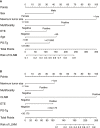Nomogram model based on preoperative serum thyroglobulin and clinical characteristics of papillary thyroid carcinoma to predict cervical lymph node metastasis
- PMID: 35909521
- PMCID: PMC9337858
- DOI: 10.3389/fendo.2022.937049
Nomogram model based on preoperative serum thyroglobulin and clinical characteristics of papillary thyroid carcinoma to predict cervical lymph node metastasis
Abstract
Objective: Preoperative evaluation of cervical lymph node metastasis (LNM) in papillary thyroid carcinoma (PTC) has been one of the serious clinical challenges. The present study aims at understanding the relationship between preoperative serum thyroglobulin (PS-Tg) and LNM and intends to establish nomogram models to predict cervical LNM.
Methods: The data of 1,324 PTC patients were retrospectively collected and randomly divided into training cohort (n = 993) and validation cohort (n = 331). Univariate and multivariate logistic regression analyses were performed to determine the risk factors of central lymph node metastasis (CLNM) and lateral lymph node metastasis (LLNM). The nomogram models were constructed and further evaluated by 1,000 resampling bootstrap analyses. The receiver operating characteristic curve (ROC curve), calibration curve, and decision curve analysis (DCA) of the nomogram models were carried out for the training, validation, and external validation cohorts.
Results: Analyses revealed that age, male, maximum tumor size >1 cm, PS-Tg ≥31.650 ng/ml, extrathyroidal extension (ETE), and multifocality were the significant risk factors for CLNM in PTC patients. Similarly, such factors as maximum tumor size >1 cm, PS-Tg ≥30.175 ng/ml, CLNM positive, ETE, and multifocality were significantly related to LLNM. Two nomogram models predicting the risk of CLNM and LLNM were established with a favorable C-index of 0.801 and 0.911, respectively. Both nomogram models demonstrated good calibration and clinical benefits in the training and validation cohorts.
Conclusion: PS-Tg level is an independent risk factor for both CLNM and LLNM. The nomogram based on PS-Tg and other clinical characteristics are effective for predicting cervical LNM in PTC patients.
Keywords: lymph node metastasis; nomogram; papillary thyroid carcinoma; preoperative serum thyroglobulin; surgery.
Copyright © 2022 Chang, Zhang, Wang, Li, Du, Zuo and Yin.
Conflict of interest statement
The authors declare that the research was conducted in the absence of any commercial or financial relationships that could be construed as a potential conflict of interest.
Figures






Similar articles
-
Constructing a nomogram based on the distribution of thyroid nodules and suspicious lateral cervical lymph nodes in fine-needle aspiration biopsies to predict metastasis in papillary thyroid carcinoma.Front Endocrinol (Lausanne). 2023 Nov 28;14:1242061. doi: 10.3389/fendo.2023.1242061. eCollection 2023. Front Endocrinol (Lausanne). 2023. PMID: 38089614 Free PMC article.
-
Nomogram for predicting the risk of cervical lymph node metastases and recurrence in papillary thyroid carcinoma based on the thyroid differentiation score system and clinical characteristics.BMC Endocr Disord. 2025 Feb 13;25(1):39. doi: 10.1186/s12902-025-01867-7. BMC Endocr Disord. 2025. PMID: 39939864 Free PMC article.
-
Predicting central lymph node metastasis in papillary thyroid carcinoma combined with Hashimoto's thyroiditis: a preoperative study.BMC Cancer. 2025 Mar 10;25(1):425. doi: 10.1186/s12885-025-13805-w. BMC Cancer. 2025. PMID: 40065226 Free PMC article.
-
Preoperatively Predicting the Central Lymph Node Metastasis for Papillary Thyroid Cancer Patients With Hashimoto's Thyroiditis.Front Endocrinol (Lausanne). 2021 Jul 22;12:713475. doi: 10.3389/fendo.2021.713475. eCollection 2021. Front Endocrinol (Lausanne). 2021. PMID: 34367075 Free PMC article. Review.
-
Meta-analysis of prediction models for predicting lymph node metastasis in thyroid cancer.World J Surg Oncol. 2024 Oct 22;22(1):278. doi: 10.1186/s12957-024-03566-4. World J Surg Oncol. 2024. PMID: 39438906 Free PMC article.
Cited by
-
Cervical lymph node metastasis prediction of postoperative papillary thyroid carcinoma before 131I therapy based on clinical and ultrasound characteristics.Front Endocrinol (Lausanne). 2023 Feb 17;14:1122517. doi: 10.3389/fendo.2023.1122517. eCollection 2023. Front Endocrinol (Lausanne). 2023. PMID: 36875475 Free PMC article.
-
Nomogram Model Based on Iodine Nutrition and Clinical Characteristics of Papillary Thyroid Carcinoma to Predict Lateral Lymph Node Metastasis.Cancer Control. 2023 Jan-Dec;30:10732748231193248. doi: 10.1177/10732748231193248. Cancer Control. 2023. PMID: 37671703 Free PMC article. Clinical Trial.
-
Nomogram for preoperative estimation risk of lateral cervical lymph node metastasis in papillary thyroid carcinoma: a multicenter study.Cancer Imaging. 2023 Jun 1;23(1):55. doi: 10.1186/s40644-023-00568-5. Cancer Imaging. 2023. PMID: 37264400 Free PMC article.
-
A comprehensive prediction model for central lymph node metastasis in papillary thyroid carcinoma with Hashimoto's thyroiditis: BRAF may not be a valuable predictor.Front Endocrinol (Lausanne). 2024 Sep 19;15:1429382. doi: 10.3389/fendo.2024.1429382. eCollection 2024. Front Endocrinol (Lausanne). 2024. PMID: 39363900 Free PMC article.
-
Prediction model of cervical lymph node metastasis based on clinicopathological characteristics of papillary thyroid carcinoma: a dual-center retrospective study.Front Endocrinol (Lausanne). 2023 Sep 11;14:1233929. doi: 10.3389/fendo.2023.1233929. eCollection 2023. Front Endocrinol (Lausanne). 2023. PMID: 37766691 Free PMC article.
References
-
- Gulec SA, Ahuja S, Avram AM, Bernet VJ, Bourguet P, Draganescu C, et al. . A joint statement from the American thyroid association, the European association of nuclear medicine, the European thyroid association, the society of nuclear medicine and molecular imaging on current diagnostic and theranostic approaches in the management of thyroid cancer. Thyroid (2021) 31(7):1009–19. doi: 10.1089/thy.2020.0826 - DOI - PubMed
-
- Craig SJ, Bysice AM, Nakoneshny SC, Pasieka JL, Chandarana SP. The identification of intraoperative risk factors can reduce, but not exclude, the need for completion thyroidectomy in low-risk papillary thyroid cancer patients. Thyroid (2020) 30(2):222–8. doi: 10.1089/thy.2019.0274 - DOI - PMC - PubMed
MeSH terms
Substances
LinkOut - more resources
Full Text Sources
Medical
Miscellaneous

